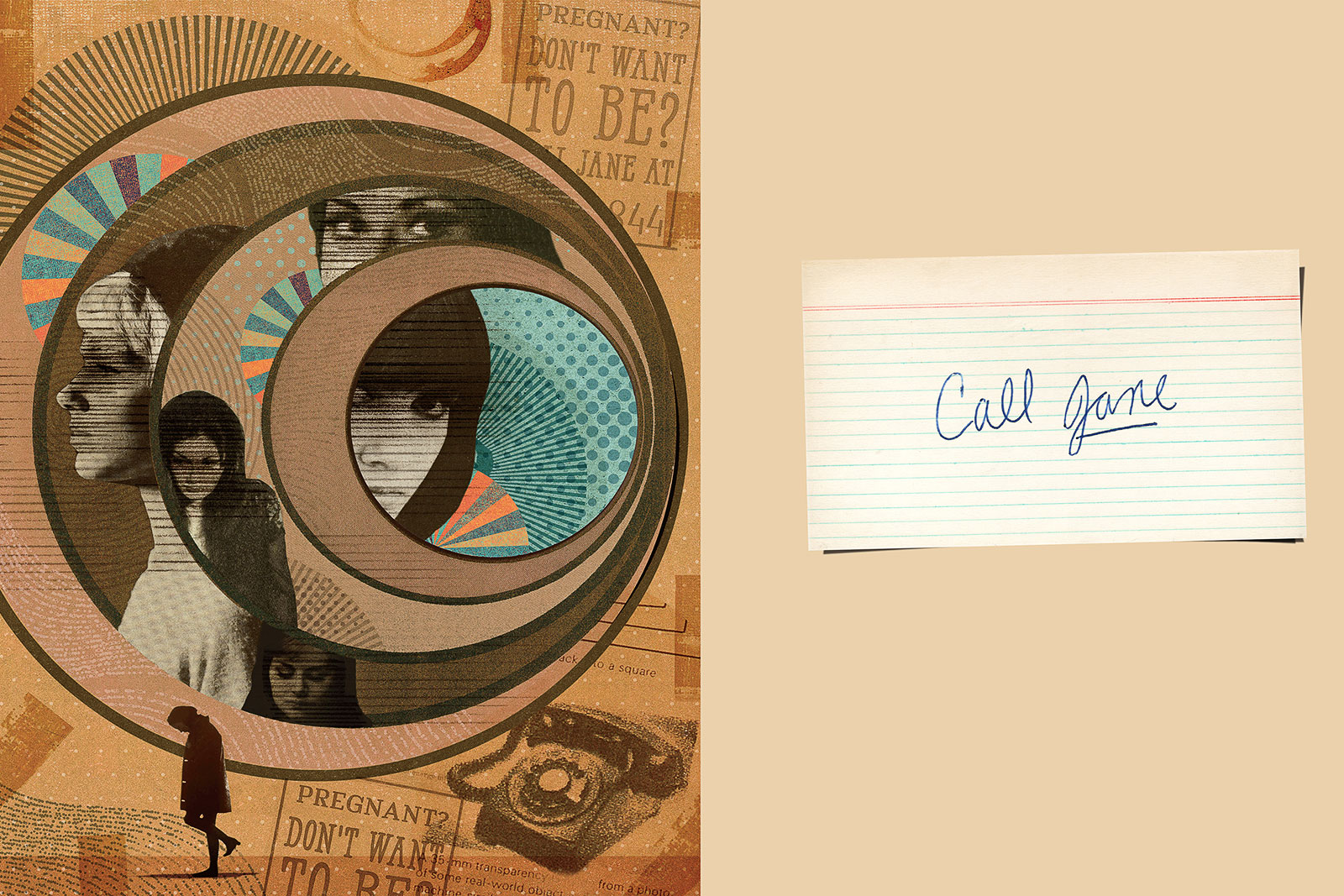In 1971, Eileen Smith was a 21-year-old dropout from Elmhurst College, broke and breaking out of a bad relationship. She was also accidentally pregnant.
She wanted an abortion, but her options were limited. Abortion was highly restricted then in Illinois, as it was in 46 other states. At that time, it could be done legally in New York, but that required airfare and a place to stay, not to mention the cost of the procedure — all of which made it unfeasible for Smith. “I thought, I cannot be pregnant; I have to do something,” she says.
Smith saw an ad running in the Seed, a local alternative newspaper: “Pregnant? Don’t want to be? Call Jane at 643-3844.” She did and was directed to a counseling session at a woman’s home. “There were kids crawling all over the place, playing, and I thought that was nice,” she says. The fee for the abortion was $500, but when Smith confessed she had only $100, she was told, “Pay us when you can.”
The day of the abortion, scared but determined, she took the L from her North Side apartment to Hyde Park, where she followed her contact’s directions to a University of Chicago dorm room. It was filled with women waiting. Eventually, a pregnant woman drove them to a different location. There, another woman explained every step of the procedure to Smith. Someone else held her hand during the abortion, preparing her for any discomfort she might experience. “I had expected the experience to be sleazy and demeaning, in a dirty room off a back alley,” she says. “Instead, it was a positive experience with supportive women. I didn’t feel like I was doing anything illegal.”
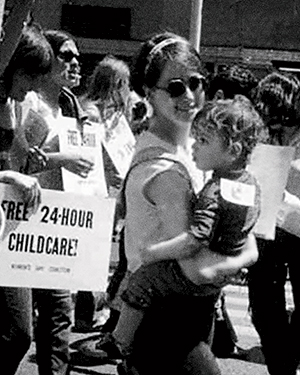
Smith had found her way to Jane, more formally known as the Abortion Counseling Service of Women’s Liberation, affiliated with the Chicago Women’s Liberation Union. Operating from 1969 until 1973, Jane was a Chicago underground network run by women for women, providing clandestine abortion services. Originally, Jane referred women to doctors willing to risk arrest, but eventually members of the group took over performing the abortions themselves in private residences throughout the city. Over the group’s lifespan, which ended the year of the Supreme Court’s Roe v. Wade decision, almost 100 women were members, though never more than 20 to 30 at one time. They were housewives, students, teachers, and social workers — but none had any formal medical training. Members of the group carried out an estimated 11,000 abortions, never refusing a woman who couldn’t pay.
Knowledge of Jane spread through word of mouth, leaflets, notes posted on college bulletins boards, and a few ads in alternative papers. The group operated with a high degree of secrecy, with members using the contact name Jane. There were Call-Back Janes, who returned phone calls, and Big Janes, who scheduled appointments. “We settled on calling ourselves Jane because we wanted a name that no one in the group had,” says Laura Kaplan, a member who wrote a memoir of the organization titled The Story of Jane: The Legendary Underground Feminist Abortion Service. “And we wanted an Everywoman name because we were for every woman having exactly as many children as she wants, when she wants, if she wants.”
This spring marks the 50th anniversary of the founding of Jane, and the debate over abortion rages on as ever — perhaps even more intensely, with President Donald Trump publicly declaring his opposition to Roe v. Wade. “In 1973, I thought this issue was going to go away,” says Martha Scott, a founding Jane member. “I thought it had been decided. But rights have just been eroded, while the need for abortions continues. People have forgotten how bad it was.”
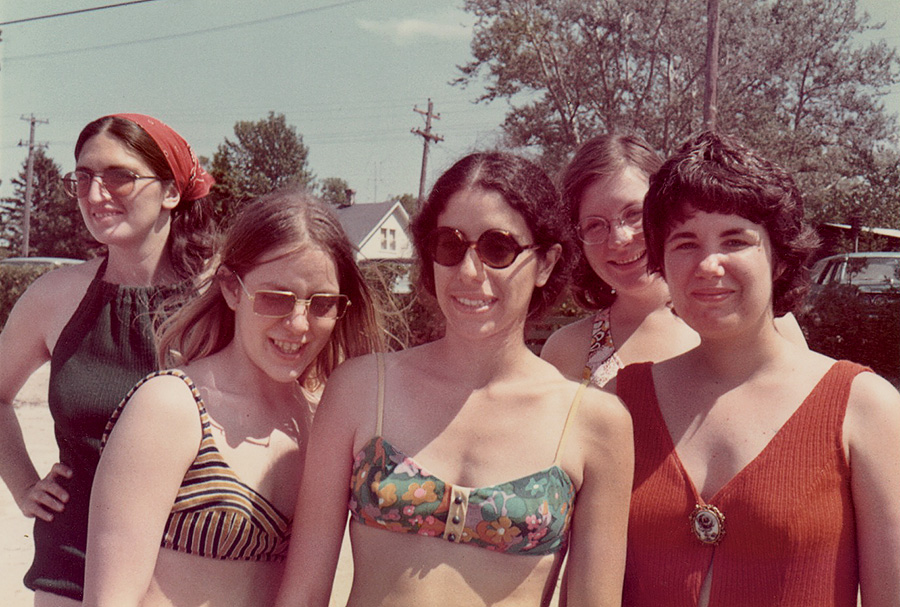
“You have to put everything into context,” says Kaplan. “Women’s health issues were extremely controlled. If you had a yeast infection, you couldn’t go buy Monistat. You needed a prescription.” In 1965, the Supreme Court overturned a Connecticut law that made it a crime for a woman to use birth control. No pregnancy kits were available in drugstores; a woman had to visit a doctor. By the late ’60s, birth control pills were being prescribed, but the side effects could be intolerable. IUDs were also used as birth control, but they weren’t fail-safe, or even particularly safe — the new-to-market Dalkon Shield would cause thousands of serious pelvic infections and lacerations and six deaths before its manufacturer halted sales in 1974. In Illinois, abortion was illegal except when necessary to save the mother’s life. Even then, it had to be approved by a hospital’s board.
A budding activist, Heather Booth arrived as an undergrad at the University of Chicago in the early ’60s, the product of a liberal Jewish household in Brooklyn, the kind of home where her mother readily discussed Betty Friedan’s The Feminine Mystique with her. As a teen, Booth had quit her high school’s cheerleading squad because it didn’t allow African Americans to join. In 1964, after her first year in college, she participated in Freedom Summer, traveling to the South with other northern students to register black voters. “I learned many lessons that summer: that you can change the world but only if you organize, that sometimes you just listen to the people you’re trying to organize, and sometimes there must be civil disobedience to carry out a moral imperative,” says Booth.
She applied those lessons two years later, when a friend called to say his sister was pregnant and frantic for an abortion. “I’d never really thought about where you could get an abortion,” says Booth. She asked around repeatedly until finally one of her civil rights contacts suggested a doctor with an office in Woodlawn. He agreed to help.
Word spread. Not long after, Booth got a call from another woman, one she had never met, asking for a referral. Then another. Then another. Through a whispered word-of-mouth network, Booth was suddenly helping students, poor black women from the South Side, middle-class wives and daughters of city workers. “I realized that abortions weren’t something only a few women needed once in a while,” says Booth. When the doctor in Woodlawn stopped responding to her calls, she tracked down some other physicians. The going rate was $600 to $1,000.
By 1968, Booth was married, pregnant, in graduate school, and working; she didn’t have the time to be involved any longer. She put her organizing skills to work, inviting women she’d met through her activist work to her Hyde Park apartment. There she explained what she had been doing and how she wanted to start an organization that would take over this clandestine work. Some women declined to join, unwilling to do anything illegal. Others were eager to get involved, including Jody Howard and Ruth Surgal.
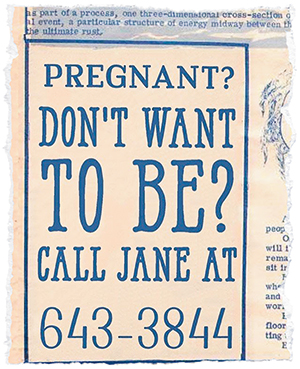
Howard had graduated from Michigan State, where she’d been prevented from joining the golf team because she was a woman. She was attending graduate school at U. of C. and served on the board of the Chicago Civil Liberties Union. Married with two children, Howard was battling early lymphatic cancer; a few years earlier, having discovered she was pregnant again, she’d sought a hospital-board-approved abortion. Even with recommendations from her oncologist and gynecologist, her request was initially turned down. Surgal was a social worker with a husband and two children at the time — an antiwar activist who was, she recalls, “looking for a place that would be my place.” With the formation of Jane, she found it.
The organizing meetings at Booth’s apartment were long. They took months to discuss details of the procedure and how to counsel women. There were questions to be dealt with: What if there’s a medical emergency? What if someone dies? What if one of the doctors gets arrested? And what if a Jane does? Howard chafed at all the talk; she had a take-action personality. Later she told Kaplan that she kept thinking, “Just give me the names and numbers of doctors and we’re ready to go.”
For security reasons, the women agreed that minimal records would be kept and that the group’s two main points of contact — with the patients and the doctors — would be handled by separate sets of volunteers. Anyone who called needing help could get it, regardless of her ability to pay or the level of complication of the procedure. Finally, in spring 1969, Booth handed the doctors’ names and numbers to Howard and Surgal and moved on to other political organizing.
The group expanded its services quickly. It got an answering machine — a big two-reel setup. Howard and Surgal maintained contacts with the doctors, other Janes returned calls, and everyone did counseling. Once they’d secured more doctors through well-formed whisper networks, Howard started negotiating fees with them, offering more volume for lower prices. Booth found a man who said he was a doctor — the group called him Mike — and he did Jane’s abortions at motels, until an irate husband showed up one day, yelling and pounding on the door.
After that, the Janes developed a new system. They kept one borrowed apartment or house, called the Front, where women would show up the day of their scheduled abortions. Women could bring family members and friends along for moral support, as well as their kids if they needed childcare during the procedure. Then a Jane member would drive only the women who were getting abortions to another apartment or house, the Place, where the abortions would be performed in a bedroom, on a bed layered with plastic and fabric sheets. Whoever was running the Front had to be part counselor, part entertainer, part babysitter for hours until the women returned. Locations of both the Front and the Place varied, from Hyde Park to Lincoln Park, South Shore to Evanston, allowing for broader access in addition to helping the group avoid police detection.
As word of the services spread, so did the base of volunteers. “I heard about Jane while I was at the playground with my kids,” says Martha Scott, who was a 29-year-old wife and mother of four when she joined the organization. “I wanted to get involved and thought, Well, I have two free hours a week.” She laughs. “And by helping, I found myself.” Scott volunteered her spacious Hyde Park home to be the Front at times; soon she was driving women to the Place. Eileen Smith went on to join after her abortion procedure as well.
It hadn’t taken long for Howard to figure out that Mike wasn’t really a doctor. He had been well trained by a physician, but he had no formal medical standing. She withheld that information from most of the group while learning from Mike to teach members how to perform abortions themselves, figuring “if he can do it, we can do it.”
Howard was the first of several Janes to learn; Scott was another. Mike had the women assist him with numerous abortions. They learned the D&C method, which involved giving an intramuscular shot of the anesthetic Xylocaine, dilating the cervix, and using a spoon-shaped curette (the C of the D&C) to scrape the uterus walls. It was delicate, risky work. A puncture of the uterus left untreated could cause internal hemorrhaging, severe infection, even death.
The group had one close brush with death. One woman came to the Janes and, upon exam, it was discovered that she had a severe infection, most likely from an abortion attempt within the previous week. Delores, as she was called in Kaplan’s book, said she had recently “tried several other things” to end her pregnancy. The group refused to perform an abortion. “She was told, ‘You’re very sick. There’s nothing we can do,’ ” says Scott. “We told her to go to a hospital immediately.” The next week the Janes learned from Delores’s family that she had waited days before seeking help. By the time she went to the hospital, it was too late. She had died there.
Delores’s death brought home to the group the high risks involved in this work. Some members quit, feeling that because Delores had come to Jane, they were responsible for her. The core group — Scott, Surgal, and Howard — argued that more women would find themselves in the same situation if Jane stopped its work.
Later the Janes learned a new method — vacuum aspiration using a flexible tube called a cannula — from women’s health advocates in California. And from an abortionist in Michigan, they secured a compound called Leunbach paste, which could be inserted into the uterus to induce miscarriages in midterm pregnancies. Mike brought the group a microscope and taught the Janes how to perform Pap smears, which they soon offered free of charge to every woman who came to them.
By performing its own abortions, the group was able to lower the standard price to $100 — and even less for those who couldn’t afford that. But when the group learned that Mike wasn’t a real doctor, some members quit in anger, feeling they had been conned and had unknowingly put women at risk. New members were quickly recruited to replace them, though. They included Kaplan, who joined after a friend had praised Jane’s work; Jeanne Galatzer-Levy, a 20-year-old student; Sheila Smith, a friend of Galatzer-Levy; Abby Pariser, a married graduate student; and Madeline Schwenk, a housewife.
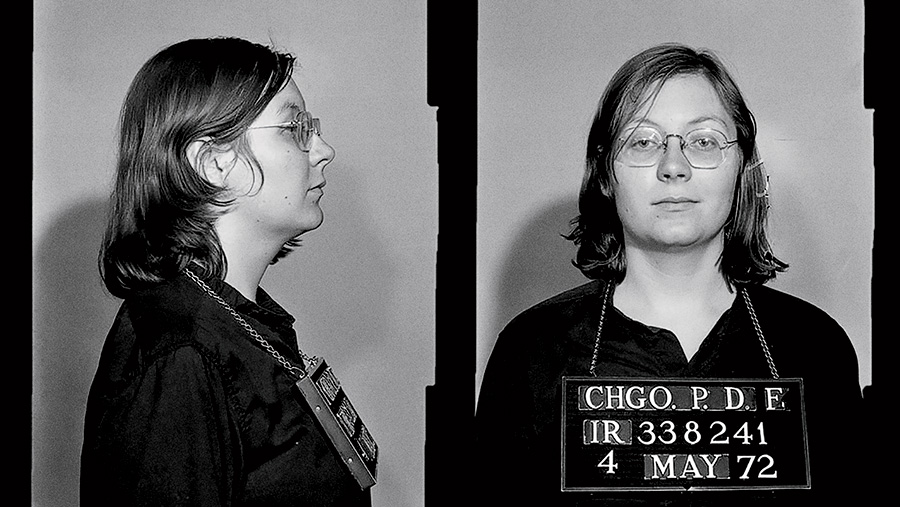
“Initially, we felt very protective about how we handled everything, not talking on the phone, watching to see if police were around,” says Scott. But gradually, the Janes felt relatively secure. There had been worries about interference from the Mafia (it was rumored that many Chicago abortion services paid for Mob protection), and one member of the group reported that a policeman saw her and said, “Hi, Jane.” But the high number of police family members seeking Jane’s services seemed to limit cops’ interest in arresting them. “Basically, we were protected within a system that didn’t really want to know that we existed,” says Scott.
That changed on May 3, 1972, when Chicago police raided both the Front, which was in a Hyde Park home that day, and the Place, in a South Shore high-rise. A woman seeking an abortion had brought to a counseling session her sister-in-law, who, it turned out, had strong antiabortion feelings. The sister-in-law later reported the activities to the police. “It was like a classic television show, with these big cops pounding on the doors,” says Scott. The police arrested seven Janes at the high-rise, including Scott, Pariser, Sheila Smith, Schwenk, and Galatzer-Levy. What minimal client information the Janes had was written on corners of index cards. As planned, they tore off the cards’ corners and swallowed them while being transported in a police van.
“The police were only interested in Jane members, not women who were there for abortions,” says Kaplan. “Those women were let go.” The seven Janes spent a night in jail, and the next day they were released on bail. They then stepped away from the group; since they’d already been outed as members, they worried their continued involvement put Jane’s services at risk. Howard, who had been taking a break from Jane, stepped back in.
For their legal advocate, the seven Janes chose Jo-Anne Wolfson, a criminal defense attorney known as the Queen of the Hopeless. Young and tough, she had, at one point, joined a traveling circus. Known for an aggressive courtroom style, including a successful 1970 defense of the Chicago Black Panthers targeted in the police raid that led to the death of Fred Hampton, Wolfson decided to keep asking for delays in the Jane case. “She knew that the Roe v. Wade case was going to be decided by the Supreme Court,” says Kaplan. “And she felt if she could delay until that was decided, and if it was decided in a proabortion way, then the case against the Janes would be over.”
The tactic worked. On January 22, 1973, the Supreme Court decided Roe v. Wade with a 7–2 vote. Abortion was now a woman’s right. Charges against the Janes were dropped and their arrest records expunged. In May of that year, an End to Jane Party was held at a member’s house in Oak Park. After that, the women went their own ways. Ruth Surgal died of a brain aneurysm in 2004 and Jody Howard due to complications from cancer in 2010. Jo-Anne Wolfson died in 2018. Eileen Smith is a visiting nurse. Laura Kaplan served on the board of the National Women’s Health Network. And Martha Scott has worked as a sexual health educator.
The cultural, religious, and political war over abortion still rages on, of course. Dozens of states have already imposed restrictions making it difficult for women, particularly those of modest means, to receive professional medical help to end pregnancies. And today approximately 90 percent of American counties do not have a single abortion clinic. Times change, and then they change again. Looking back on the history of Jane, then, may provide a glimpse into the future, one where ending a pregnancy requires extraordinary action.
Not that Jane members see their legacy that way. “Sometimes people call the members of Jane heroic,” says Scott. “But we were ordinary people trying to help others.”



